Note: The following photos appear a lot smaller than on previous posts as I am using a different computer now that we're home. You can access them in a larger format by reading the post on:
www.bergersadventures3.blogspot.com
Thank you for your patience as I find and make time during the holidays to finish writing the remaining posts of our incredible trip.
12/4: The previous night at dinner at our favorite sandwich shop, Steven
mentioned he had had enough of Kathmandu already and
wished we had spent an extra day in Kuala Lumpur, Malaysia, where we had been before coming to Kathmandu .
It was such a shame and I was so surprised as he had been so looking forward to
returning to Nepal .
When Air Asia postponed our flight from Kuala Lumpur ,
he had been very disappointed as it meant one less day in Kathmandu .
Waking up this morning to having no heat and only 1
minuscule light in the room because the hotel had no backup generator did not
further endear Steven to Nepal
Yesterday we had negotiated with the same taxi driver who had driven us to Bhaktapur to take us to 4 places located in the Kathmandu Valley today. He picked up at 8:30
and we were on our way first to Kopan Monastery located atop a hill northeast of
Kathmandu about distance .
Steven and I agreed that most of the drive
there were on the worst stretches of road we had ever been on AND we had been on
some doozies, let me tell you. At one point, I wished I’d said I would get out
and walk on the sidewalk as it was in great shape compared to the rocky,
boulder strewn road. It took him well over an hour to reach the monastery even though it was only 5 miles away! We arrived at 9:45
in one piece although every bone ached in my body from the journey.
Photos from Kopan Monastery:
Above and below: Kopan Monastery welcome signs!
Kopan Monastery was established in 1970 as a center
of Tibetan Buddhist learning in response to a strong wish expressed by the
religion’s Buddhist students for spiritual guidance and for a place to study.
It was also conceived as a place of study for young people of this area of
Nepal and the monastery is now home to more than 750 monks and nuns from the
Himalayan region.
Tibetan Buddhism is under severe threat of being lost in Tibet
after the Chinese invasion of Tibet
in 1959 which resulted in many of the monasteries being destroyed and thousands
of Tibetans fleeing their home country. Since then, many of these monasteries
were re-established in Nepal
and India and
it is now in the monasteries outside of Tibet
that the pure Tibetan Buddhist tradition is being preserved and developed.
Kopan is one of those monasteries which passes on the ancient traditions of Tibetan
Buddhism to the younger generation.
Views of hazy Kathmandu in the
morning fog.
Photos of the Prayer Hall:
We heard a priest preach to a large group of Westerners who
had come to Kopan on a retreat. Even though the Buddhist priest spoke in
English, I found his rambling speech to be almost incoherent so we left after
10 minutes or so to wander around other parts of the monastery.
Everywhere we looked we saw profusions of orange marigolds.
Each letter of the word Kopan was spelled out in orange
marigolds on one of the trees.
The flowers throughout the grounds were beautifully attended
to and so lovely to see as we hadn’t seen any flowers in Kathmandu .
Dorms for Buddhist students of all ages who come to Kopan for either short meditation courses, the month long course or private study and retreat.
What massive orange marigolds; you
see them at every Buddhist temple all over the world.
Noticed the damage from the April earthquake as we walked around
more of the monastery.
We left Kopan at 11 after spending some time in the
monastery bookshop cum souvenir shop as they had a lot of attractive items for
sale. Lucky us (I am being very sarcastic here!) – the road to our next destination, Bodhnath, took us
back on the same stretch of horrendous road we had been on earlier but we arrived
there just 30 minutes later so we didn’t have too much time to feel as jostled.
Cooking gas canisters waiting to be filled in the gas shortage.
We saw lots of electric vehicles only in Bodhnath; they were similar to a tuk tuk.
Photos from Bodhnath:
Historically Bodhnath was an important staging post on the
trade route between Lhasa in Tibet
and Kathmandu. Tibetan traders would pray here for a
safe journey before driving their yaks on to the high passes of the Himalayas .
Today, most of the Tibetans living in the village
of Boudha their homeland
in 1959 after the Chinese invasion of Tibet as I mentioned above . As there are well over 5,000 Tibetan exiles living in the
valley, Kathmandu has assumed a distinctly Tibetan
ambiance.
Stupas were originally built to house holy relics and some
claim that Bodhnath contained the relics of the past Buddha while others say the
solid dome contained a piece of bone from the historical Buddha. The 13 steps
to the dome symbolized the 13 stages of enlightenment which give the monument –
enlightenment or Bodh, and God, nath – its name.
Until the April earthquake, Bodhnath was Asia ’s
largest stupa. The first stupa at Bodhnath was built sometime after 600 A.D.
when the Tibetan king converted to Buddhism. According to legend, the king constructed
the stupa as an act of penance for unwittingly killing his father.
Unfortunately the first stupa was wrecked by Mughul invaders in the fourteenth
century so the current stupa is a more recent construction.
The before and after earthquake photos of Bodhnath. How glorious it must have been before the earthquake.
We began making the (obligatory) clockwise circuit of the heavily damaged but still massive monument that was surrounded on all sides by shops, restaurants and homes.
People walked around and at times touched the prayer wheels that encircled the entire stupa.
We saw a sign
pointing out some nearby monasteries down a narrow alley. We followed it as we
wanted to visit some of those we had information on.
We had never seen so many signs advertising schools as we did all over Kathmandu as well as Bodhnath .
Sewing Buddhist prayer flags.
Beautiful recycled Himalayan crafts sewn from remnants of women’s
skirts.
Photos of Shechen Monastery:
This huge complex was established by a famous Buddhist
priest to replace the destroyed Shechen Gompa in eastern Tibet .
The monastery has a community of over 300 monks and novices.
We would have loved to have seen the main prayer hall as it was supposed to have had fabulous murals done by artists from Bhutan but, unfortunately, the hall was closed because of damage suffered in the earthquake.
Had never seen a sign before at any place of worship barring
the use of plastic bags on site. The temple's Eco Committee was responsible for their ban.
I loved seeing and then taking photos of Nepali women wearing traditional clothing.
As quickly as the precious wood was unloaded, it was carried
away by those needing it for cooking and heating their homes.
Since the Chinese sent thousands
of troops to enforce their claim on Tibet in the 1950s, dozens of new monasteries were constructed in
Bodhnath by refugees. We walked to just a few of them. The first was Samtenling
Gompa; gompa is another word for monastery.
We could hear very discordant
sounds of monks learning to play what sounded like a clarinet; it was obvious
that they had only just begun!
Sakya Tharig Gompa was
the next one we wandered to but we could only view it from afar because of the
extensive damage.
Just for you, Judy! Photo of many singing bowls in a shop by the stupa in Bodhnath.
We were back in the car to go to the Hindu
Temple
Photos from
The first thing I noticed as we entered the area by the Hindu temple at Pashupati were these incredibly vibrant colored powders – what a feast for the eyes.
Seeing them made me feel such sorrow for blind people who could never
appreciate their brilliance.
Pashupati is the holiest and most famous of all Nepal ’s
Hindu shrines. Set on the banks of the Bagmati
River about 3 miles northeast of Kathmandu
Only Hindus needed to remove their shoes at the Free Shoe
Service as they were the only ones permitted to enter the temple below.
Hindu followers exiting the temple with their prayer offerings.
There was, however, a large area adjacent to the temple that we were able to walk around and view followers paying homage to their religion.
Death in Pashupati is marked by cremation at any one of the many burning
places near the holy Hindu bathing places or ghats, which line
the banks of the Bagmati River
As we stood on the footbridge
above the river with many other people, we could all hear the profoundly sad
wailing of a woman below who was mourning the death of her loved one. I can
still 'hear' her keening today as I write this 3 plus weeks later.
There were almost exclusively men at the site on the river
where the bodies were being burned on the funeral pyres. Steven had forewarned me about the cremations that we'd see in Pashupati and especially at our next stop, in Varanasi, India, so I was 'prepared' for the solemn sights and sounds. I found our relatively brief time in Pashupati very moving.
I took several photos of the market stalls that were
adjacent to the temple. They too had a profusion of orange marigolds for sale
as well as other items for Hindu funerals.
Our driver's very dented and ancient taxi. After being in it for close to 2 days and experiencing every bump in the road, we decided to take our chances on renting another one when we needed to return to the airport in the hope that its interior would be more attractive and suspension more comfortable.
We were back in the car by 2:15
to drive to our last stop, the town of Patan Kathmandu .
Photos from Patan:
Above, the town’s entrance gate. We had to stop here and buy entrance tickets to the town's historic area. What fancy entrance tickets we got to the town’s historic
area; in all the places we’ve gotten entrance tickets around the world, we’d
never been given cloth ones before! My hope (fantasy perhaps!) is to someday arrange all our entrance tickets I have saved from this trip as well as those from our 2013 and 2014 trips in albums or frame them all so we would be constantly reminded of our incredible adventures. What a great memory 'book' it would for each trip but the process of actually doing it sounds rather daunting.
En route to Patan's 16th century Durbar Square:
Some say that the city of Patan
was designed and built after the Buddhist Dharma Chakra or ‘Wheel
of Enlightenment.’ It is surrounded by 4 big stupas, one at each corner of its
cardinal points. These monuments are said to have been built by the Indian
Emperor Ashoka when he came to Kathmandu
Valley
There are more than 1,200 Buddhist
monuments of various shapes and sizes scattered in and around Patan. The most
important is Durbar Square Durbar
Square was full
of ancient monuments, temples and shrines.
We made our way to Patan
Museum Nepal .
Unfortunately we got there when one of the roving power outages was occurring
throughout the city, so we did not appreciate the museum as much as we would
have if we had been able to see the displays and read the descriptions.
The Museum was one of the royal palaces of the former Malla kings of Kathmandu Valley and dates from 1734. The majority of exhibits were sculptures of Hindu and Buddhist deities.
The stone relief originally adorned a temple about 18 miles east of the capital before it was stolen in 1982 and sold to a German art dealer. Considered one of the 'Stolen Gods of Nepal,' it was returned in 2000
after being spotted in a museum catalog in Berlin .
Titled Inscription with Shivalinga, Cow and Calf: Note the sacred cow of Hinduism. The scene relates to the inscription which records the gift of pasture land dedicated to the cost of feeding a special food to cows.Four Faced Linga: the Symbol of Shiva.
Narada, the Heavenly Musician.
The Sun God Surya.
The bronze and painted seventeenth century Dipankara, the Buddha of Fixed Light.
17th or 18th century copper and gilt Torso.
Photos from the Museum: Above, of Durbar Square; below, the Museum's interior courtyard.
Our
The Mulchowk or main courtyard had tile paving from the 17th century.
The Golden Doorway to the Taleju Temple inside Mulchowk is considered a fine example of the metallurgical arts of Patan.
The adjacent 3 story Sundari Chowk or courtyard was originally built in 1628 and was home to the Tushahiti Step Well which was commissioned in 1647 by one of the Malla kings to perform ritual ablutions.
Sculptures of Hindu and Buddhist gods encircled the
ornamental pool where Patan’s seventeenth century kings and queens bathed. The
large stone snake coiled protectively around the outer circle warding off evil
spirits.
After leaving the Museum, we continued walking around Durbar Square. Below is the stone Krishna Temple or Mandir that was built in the seventeenth century. It is the only temple in Nepal with 21 golden pinnacles. Most of the important scenes from ancient Hindu epic were carved on its friezes.
The taxi driver had told us to be back by 4:30 so we scooted back there only to be unable to find
him. Rather than waiting patiently for him to show up, we decided to take
advantage of the extra time and walked toward the Golden
Temple below
Photos of Golden
Temple
Shree Shakya Muni Buddha.
It had been a long day and, even though we didn’t cover a
lot of territory, the roads were in such horrific shape, it had been tiring. We
were relieved to return to the hotel and find we had heat and electricity for a
bit before it conked out again.
Posted on 12/27 from our home in Littleton, Colorado.
























































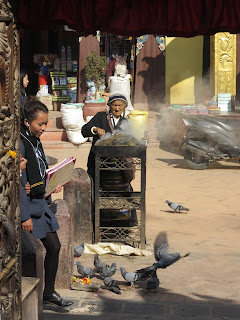



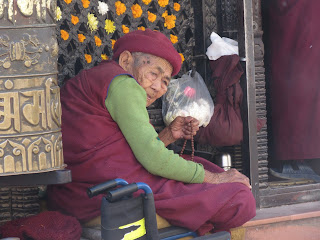














































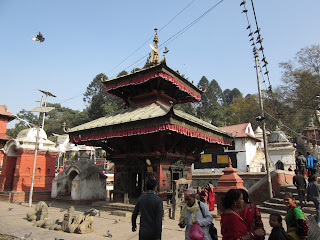



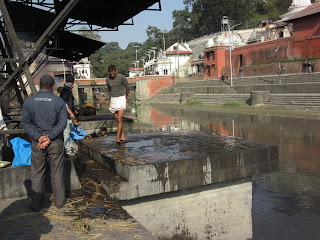














































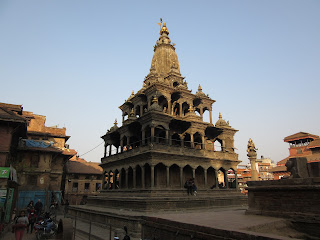

















Wonder what would happen if we would all follow the Dalai Lama's statements that you found in the beginning of this day. Lil Red
ReplyDelete